
Please check your daily skincare products: Start by ensuring your cleanser is labeled as ‘pH-balanced.’ The sharp sting of soap against freshly washed hands is a reminder that our Skin is more than a covering—it’s a living organ that protects us from pollution, sunlight, and germs. A key, but often overlooked, aspect of skin health is its pH level. Although ‘skin pH’ is mentioned in ads, many remain unaware of its significance. The Skin’s pH affects acne, dryness, aging, and sensitivity. But here’s the good news: simple habits, such as using pH-balanced cleansers and avoiding harsh soaps, give you the power to maintain your Skin’s balance. This essay covers the basics of pH, its significance for the Skin, and provides practical tips for keeping your Skin’s pH balance.
The term pH means “potential of hydrogen” or “power of hydrogen,” and refers to hydrogen ion concentration in a solution. It is a 0–14 scale that measures the acidity or basicity of a substance. Lower numbers are more acidic, seven is neutral, and higher numbers are more basic. Lemon juice is highly acidic (pH ≈ 2), pure water is neutral (pH = 7), and baking soda is basic (pH ≈ 9). Each step on the pH scale is ten times stronger or weaker than the last—a pH of 5 is ten times more acidic than a pH of 6. Healthy skin pH ranges from 4.5 to 5.5, a level that helps keep the Skin resilient against external aggressors.
Consider Jane, a fictional example of someone using traditional soap with a high pH of 9. She often noticed that her Skin felt tight and dry, and she experienced frequent breakouts. After switching to a syndet cleanser with a pH level closer to the Skin’s natural value, she noticed that her Skin became more hydrated and comfortable, with fewer breakouts after just a week. This change demonstrates how matching skincare products to the Skin’s natural pH can lead to noticeable improvements.

The Skin’s slight acidity is crucial for maintaining its health. It strengthens the Skin’s barrier, keeping out dirt and irritants, and helps the Skin retain moisture. It also helps good bacteria grow, which in turn protects the Skin and prevents harmful bacteria and fungi from growing. Many essential skin functions, such as cell production, dead skin removal, and maintaining skin moisture, work best when the Skin is slightly acidic. This helps keep your Skin smooth and healthy.
The acid mantle is your Skin’s invisible shield—a skinny, protective layer that keeps out harmful bacteria and viruses, prevents excessive water loss, and maintains the health of the Skin’s beneficial bacteria. Knowing that your Skin has this natural defense system in place can give you a sense of reassurance about your Skin’s health.
When the acid mantle is intact, the Skin is balanced and resilient. Disruption—often caused by harsh cleansers, overexfoliation, or environmental stress—leads to dryness, irritation, and a higher risk of acne or premature aging. Maintaining a healthy acid mantle is crucial for skin vitality.
Although the Skin naturally maintains a slightly acidic pH, several internal and external factors can influence this delicate balance.
One of the main factors that can upset skin pH is the use of soaps and cleansers that are too alkaline, with a pH level between 9 and 10. These products can remove the acid mantle, making the Skin more susceptible to irritation. It’s also important to consider age: newborns have skin pH close to neutral, around 7, but it becomes more acidic in a few weeks as the acid mantle forms. Similarly, older adults typically have higher (less acidic) skin pH levels, which can make their Skin drier and more sensitive. Understanding these age-related changes can help you be more considerate of your Skin’s changing needs.
Different body areas also have varying pH levels—for example, the face, groin, and armpits each maintain slightly different acidity due to differences in sweat and Oil production.
Other factors that can alter Skin pH include your diet and hydration, the weather (such as heat and pollution), and skin conditions like acne, eczema, and dermatitis.
In skin clinics, skin pH is checked using special meters with flat tips that gently touch the Skin. These give more accurate results. pH strips you can buy at a store do not work as well because they can be affected by skin oils, sweat, or rough Skin. To check on your Skin, pay attention to changes such as dryness, sensitivity, or new roughness—these can indicate that your pH has changed. You can try pH strips before and after washing, but the results may not be precise, which is why experts use specialized tools for accurate readings.
Your Skin is home to many tiny living things, like bacteria, fungi, and viruses. Together, they form what is called the skin microbiome. Most of them do not harm you and help keep your Skin healthy. The Skin’s pH decides which bugs grow best: good bacteria, like Staphylococcus epidermidis, do best in acidic conditions. Harmful bacteria, like Staphylococcus aureus, prefer less acidic (more alkaline) environments. Changing the Skin’s pH can upset this balance, leading to more infections or irritation.
In the top layer of your Skin, important workers called enzymes help keep the barrier strong, but they need a slight acidity to function optimally. For example, some enzymes produce fats called ceramides, which trap moisture and prevent irritants from entering. These enzymes work best when the Skin has a slightly acidic pH. If the Skin is less acidic, these enzymes slow down, which harms the barrier and causes dryness and damage.
A healthy skin pH is essential for both function and appearance. Choose cleansers that are pH-balanced (ideally 5–7) to clean without disrupting your acid mantle. Avoid washing too often, as excessive cleansing strips the Skin of its natural oils and damages the Skin’s barrier. Use moisturizers that are close to your Skin’s pH to hydrate and balance your Skin daily. Limit harsh scrubs or abrasive treatments, as they can change pH and cause harm. Be mindful of product layering—some actives, like vitamin C, require a specific pH to work effectively. Balance these with other treatments to protect skin health.
Some pH mismatches aren’t just about pH—they’re about stability:
Morning (brightening + protection):
Night (repair + exfoliation):
Even with this knowledge, it’s easy to encounter misinformation. Here are some common myths regarding skin pH:
Understanding these truths empowers you to make better skincare choices that protect and enhance your Skin’s natural balance. Prioritize using pH-balanced products and adopt gentle skincare routines to maintain and support your Skin’s natural harmony.